Cancer Center Marks 50 Years of National Cancer Act
UArizona Cancer Center has been at the forefront of advancing cancer prevention and treatment
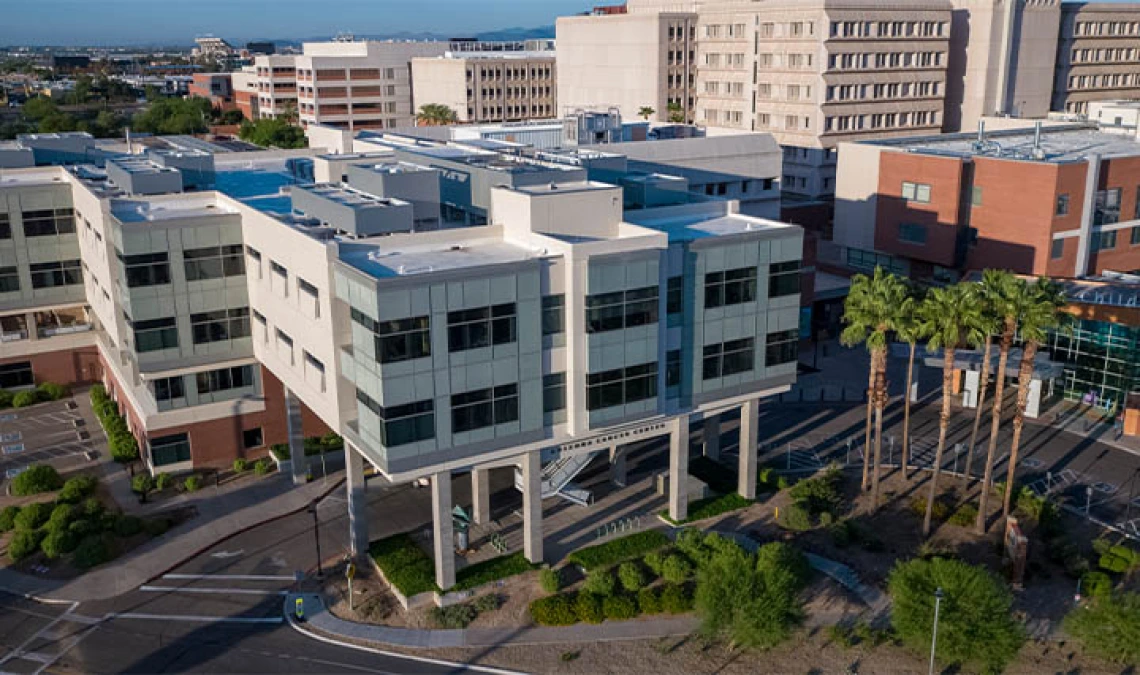
Cancer touches nearly everyone. According to the American Cancer Society, one in every two men and one in three women will have cancer in their lifetimes. Those lucky enough not to develop it themselves almost certainly know a loved one affected by the disease.
Comprehending this immense public health threat, Congress and President Richard M. Nixon enacted the National Cancer Act 50 years ago on Dec. 7, 1971. The unprecedented wave of funding the act unleashed ignited cancer research and laid the foundation for the creation of premier cancer centers around the country – including at the University of Arizona.
Picture1.pngOpening Doors: From left: Sydney E. Salmon, MD; University of Arizona President Henry Koffler; Arizona Gov. Bruce Babbit and Vincent Fulginiti, MD.

Opening Doors: From left: Sydney E. Salmon, MD; University of Arizona President Henry Koffler; Arizona Gov. Bruce Babbit and Vincent Fulginiti, MD.
Five years after the signing of the act, the University of Arizona Cancer Center was founded as a division of the College of Medicine and Center of Excellence in the Arizona Health Sciences Center.
In its 45 years, UArizona Cancer Center researchers and clinicians have contributed to groundbreaking discoveries that transformed a deadly disease into a manageable illness for many patients. Both nationally and locally, cancer death rates have declined since the 1990s even as the frequency of cancer cases holds steady.
In 1978, the Cancer Center received its first National Cancer Institute (NCI) Cancer Center Support Grant, which has been competitively renewed each cycle. That same year Cancer Center founder Sydney Salmon, MD, with Anne Hamburger, PhD, published their pioneering method for growing a patient’s tumor cells in the lab and testing them to determine which chemotherapy would work. Setting the stage for personalized care, their work was featured on the cover of Time Magazine.
Prevention is the Best Medicine
From the start, the center was not only focused on cancer treatment but also prevention. The cancer prevention and control (CPC) program was spearheaded in 1979 by David Alberts, MD, an oncologist who would go on to become the Center’s third director.
“Our leadership had a vision that very few in the nation did for decades,” said Cynthia A Thomson, PhD, RDN, current co-leader of the CPC program. “In recent years, prevention has become an important component of being an NCI-designated Cancer Center, but we had it in our hearts before we were mandated to do it.”

Dave Alberts, MD
Among Dr. Albert’s contributions was a landmark study, published in the New England Journal of Medicine in 2000, that rejected the hypothesis that wheat bran fiber supplementation helped prevent colon cancer from reoccurring. The study also set a benchmark for conducting large, population-based studies in which healthy volunteers are recruited from community physician practices.
The CPC program, co-led by H-H. Sherry Chow, PhD, continues to be a worldwide leader in prevention, participating in large NIH-funded trials, training prevention scientists and co-authoring the American Cancer Society’s 2020 Cancer Prevention Guidelines as well as other national guidelines.
Focus on a Silent and Deadly Cancer
Beyond prevention efforts, Dr. Alberts advanced new treatments for ovarian cancer, including delivering chemotherapy directly into the abdomen or pelvis through a tube, where the cancer was located. Known as intraperitoneal therapy it targeted cancerous cells while causing less harm to healthy cells. It remains the safest and most successful ovarian cancer treatment available.
The Cancer Center continues to address major obstacles in ovarian cancer, one of the deadlier cancers. For example, there is currently no widespread screening method for ovarian cancer. Most cases are found in an advanced stage. To combat this problem, Jennifer Barton, PhD, has engineered a minimally invasive scope to image the fallopian tubes, where ovarian cancer often begins.
Translational Research Gains Traction in Lymphoma
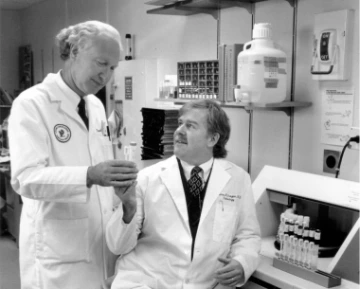
Teamwork: Thomas Miller, MD (left) and Thomas Grogan, MD
Lymphomas are cancers that begin in the white blood cells of the immune system. Starting in the 1980s, Thomas Miller, MD, director of the Center’s lymphoma program, and Thomas Grogan, MD, a pathologist, tested lymphoma biopsies with newly created antibodies and correlated patient outcomes with the laboratory results. Their findings were a milestone, showing that lymphoma subtypes could be more accurately diagnosed and help predict survival.
But this technique was very labor intensive, time-consuming and not standardized. Dr. Grogan set out to automate the process, launching the spin-off company Ventana Medical Systems. In 1992, Ventana sold the first automated tissue testing machine. Rapidly adopted around the world, it enabled more efficient, precise and standardized testing and diagnosis of cancer in patients.
Dr. Miller and Dr. Grogan’s work on lymphoma was further advanced by the addition of Lisa Rimsza, MD, to the team in the 2000s. Using RNA arrays, they were able to further correlate patient outcomes to molecular changes in the tumor, ultimately leading to the commercialization of a nanostring methodology for molecular subtyping of diffuse large B-cell lymphoma.
Dr. Miller was also noteworthy for leading national trials that defined the modern chemotherapy strategy, known as CHOP, for advanced stage diffuse B-cell lymphoma, which was published in the New England Journal of Medicine in 1998.
Today, the lymphoma group is forging a path toward better outcomes with lower toxicity for lymphoma patients. Recently, the team led a large NCI-funded National Clinical Trials Network trial to determine the optimal treatment strategy for limited-stage diffuse large B-cell lymphoma, which showed that PET imaging can guide treatment and allow many patients to forego a round of radiation and radioimmunotherapy.
New Therapies Come to Fruition
1990 marked an important milestone for the center, which received its Comprehensive Cancer Center designation from the NCI, their highest ranking.
“It took a bunch of talented people from different backgrounds coming together in order to become a Comprehensive Cancer Center,” said Anne Cress, PhD, who has been at the center since its founding. “We received it because we had outstanding research and clinical care, as well as outstanding education and outreach to the community.”
During this time, Robert Dorr, PhD, leader of the UACC’s therapeutic development scientific program and chemist Victor Hruby, PhD, were developing a compound that mimicked a hormone, naturally made in the body, responsible for skin tanning. Originally conceived as a defense against skin cancer, the agent was well-tolerated and led to remarkable skin tanning in healthy volunteers, as reported in the Journal of the American Medical Association in 1991.
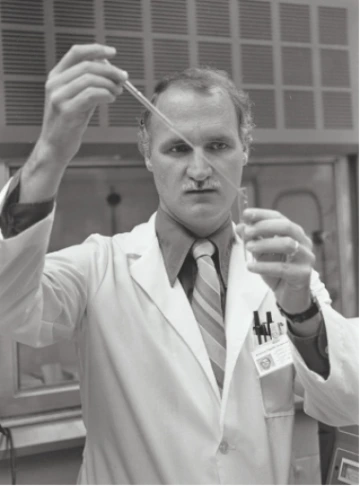
Robert Dorr, PhD
Dr. Dorr continued to develop the agent with a company in Australia, leading to its eventual approval in the United States, Australia and the European Union to treat the rare genetic disorder erythropoietic protoporphyria, which causes severe pain and blistering from the sun.
“It's a total lifestyle changing therapy for these patients, who basically had to live inside because daylight hurt,” said Dr. Dorr. And the story is not over, as the drug is being tested for xeroderma pigmentosum, another rare genetic condition that causes skin tumors, as well as for stroke and other conditions.
Focus on the Most Common Cancer in Men
Since joining the University of Arizona in 1980s, pathologist Raymond Nagle, MD, PhD, set out to better understand prostate cancer and improve diagnosis and treatment. Together with Dr. Cress and others, they were one of the first to characterize abnormal prostate cells called prostatic intraepithelial neoplasia (PIN) lesions.
In 1992, they showed that these lesions were genomically unstable like invasive prostate cancer and were also very slow growing, meaning that the anti-proliferative cancer drugs used at the time would be ineffective and only cause unnecessary toxicity. Dr. Nagle and Dr. Cress went on to evolve the field’s understanding of the tumor microenvironment and how these lesions transform into invasive cancer that spreads beyond the prostate.
Guiding the Center into the New Millennium
After a lifetime devoted to fighting cancers in others, Cancer Center founder and director Dr. Salmon found himself battling pancreatic cancer. In 1999, he asked his one-time mentee and longtime friend Daniel Von Hoff, MD, to guide the Cancer Center into the new millennium.
“What stood out to me most in coming to the Cancer Center was the excellent patient care we delivered,” said Dr. Von Hoff. “When someone walked into the building, they felt that they were being extraordinarily well cared for. And a lot of people have walked out of that building that wouldn’t have without this care.”
Breakthrough Discoveries in Cancer Biology and Beyond
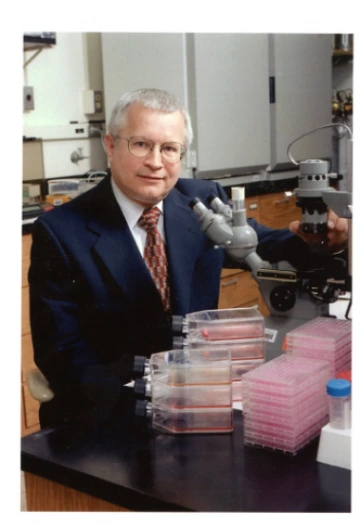
Daniel Von Hoff, MD
While at the center, Dr. Von Hoff continued to advance new treatments for pancreatic and other cancers, including a nanoparticle-bound form of the anticancer drug paclitaxel that can be more effective and have fewer side effects than other forms of paclitaxel. In addition to improving survival for patients with stage IV pancreatic cancer, the drug, called nab-paclitaxel is approved to treat breast and non-small cell lung cancer. Rachna T Shroff, MD, MS, who directs the center’s Clinical Trial Office, is leading a multi-site phase 3 trial to see if adding nab-paclitaxel to two currently-used drugs improves survival of advanced biliary tract cancer patients.
One of Dr. Von Hoff’s first acts as director was to recruit his longtime collaborator to join him here. Laurence Hurley, PhD had spent more than a decade studying telomeres – the pieces of DNA at the end of our chromosomes. This stretch of DNA can fold into a complex structure, called G-quadruplexes, which were thought to help protect the DNA. Since cancer cells can hijack the telomere system to stay alive, Dr. Hurley hoped to target these structures with anticancer drugs.
However, the story of G-quadruplexes was not so simple. In a breakthrough paper in the Proceedings of the National Academy of Sciences in 2002, Dr. Hurley and his team showed that these structures also form elsewhere in our DNA, where they help control gene expression.
“Very few people believed us at the time, which made it hard to get funding to keep exploring,” said Dr. Hurley. “But we did, and now there are hundreds of research groups around the world working in this area.”
He further found that G-quadruplexes helped keep the c-MYC gene turned on. This gene was known to drive many types of cancers, and researchers had long sought unsuccessfully to target c-MYC in cancer. But Dr. Hurley was able to synthesize a drug that targeted c-MYC through the G-quadruplex. First tested in phase I trials at the Cancer Center, the drug is now licensed to a company and in phase 2 trials for BRCA1/2-mutated breast and ovarian cancers. Dr. Hurley, meanwhile, has made follow-up drugs able to cross the blood-brain barrier that will be tested in clinic against brain cancer.
Tackling Cancer Disparities
The Cancer Center’s catchment is diverse, with a large rural and elderly population, Hispanic and border communities and seven Native American tribes. According to the Centers for Disease Control and Prevention (CDC), Native Americans have much higher rates of several cancers, including colorectal, liver and stomach cancers, compared to non-Hispanic whites.
To help combat this inequity, the Cancer Center and the Northern Arizona University launched the Partnership for Native American Cancer Prevention (NACP) program in 2002. Through research, training and community outreach, the NACP is the only NCI-funded partnership to exclusively focus on cancer disparities in Native Americans. Mentorship is a critical component and has helped engage and train many Native American students in cancer research.
Through efforts such as the NACP, Cancer Center researchers have identified the factors that go into these disparities, including exposure to environmental toxins and barriers to cancer screenings. A shot of funding from the NCI’s Cancer Moonshot Initiative is helping address the latter.
The Cancer Center strengthened its commitment to addressing health disparities under the direction of Dr. Alberts, who was named the director in 2005. One of his first efforts was the formation of the Skin Cancer Institute to address the high rates of melanoma in the state through research, advocacy and outreach on prevention, early diagnosis and treatment.
In 2012, Institute researchers realized that melanoma cases were being severely underreported to the Arizona Cancer Registry at the Arizona Department of Health Services. They set up a task force with the department and implemented strategies to get an accurate accounting of cases in Arizona. The task force continues to meet monthly and train dermatologists and pathologists on how to report to the registry.
“Accurate reporting is essential for understanding whether our efforts are making a difference,” said Robin B Harris, PhD, MPH, co-director of the Skin Cancer Institute. “Our task force is seen as a model by the CDC on how to get more accurate cancer reporting in other states.”
Expanding Access to Bone Marrow Transplants
The first bone marrow transplant in Arizona was performed at the newly created Cancer Center’s Hematopoietic Transplant Program in 1988. Since then, the team has carried out nearly 3,000 transplants for leukemia, lymphoma and other conditions.
However, more than half of those receiving transplants at the center are ethnic or racial minorities. Without a matched relative, these patients are unlikely to have a matched unrelated donor and therefore must rely on a half-matched – or haploidentical –transplant that comes with greater risks. For years, the program’s director, Emmanuel Katsanis, MD, has pursued safer, better methods to perform these transplants in children. Since 2014, the team has carried out 40 haploidentical transplants in adults and 46 in pediatric patients, who have had a similar success rate as children with a matched sibling.
2014 was also the year that the Center had its fourth permanent director, Andrew S. Kraft, MD. A nationally recognized prostate cancer physician-scientist, he successfully recompeted the NCI’s Cancer Center Support Grant and expanded the Cancer Center’s footprint to Phoenix.
The Future is Bright
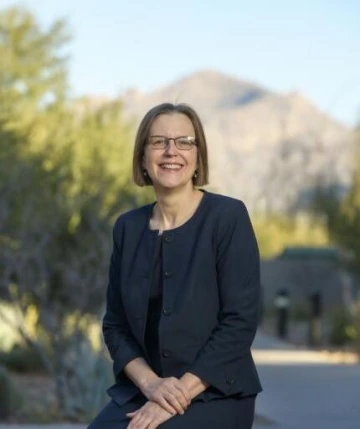
Dr. Joann Sweasy, Director, and Nancy C. and Craig M. Berge Endowed Chair of the University of Arizona Cancer Center
Dr. Joann Sweasy, Director, and Nancy C. and Craig M. Berge Endowed Chair of the University of Arizona Cancer Center
Joann Sweasy, PhD, was named the fifth director of the Cancer Center in 2020 and immediately tasked with guiding it in the midst of the COVID-19 pandemic. Under Dr. Sweasy’s direction, the Center has continued serving cancer patients with cutting-edge cancer care, research and treatment, including the launch of the Arizona Clinical Trials Network. And in 2020, a generous donor gift established the Ginny L. Clements Breast Cancer Research Institute at the Cancer Center. While still in the development stage, the goal is to become a premier center for breast cancer care and research in the country.
“I look forward to a bright future at the Cancer Center as we continue to advance first-class cancer research and clinical care,” Dr. Sweasy said. “We will continue to build upon the strong basic, translational and clinical sciences with community engagement, and I am committed as well to increasing the diversity of the next generation of cancer researchers.”








